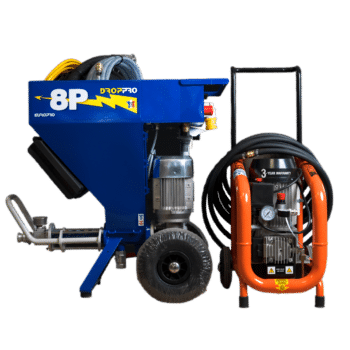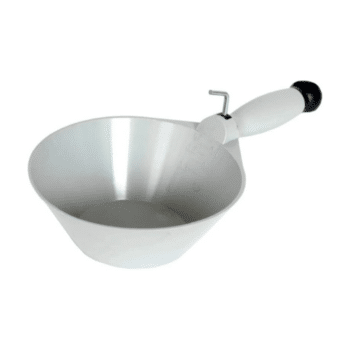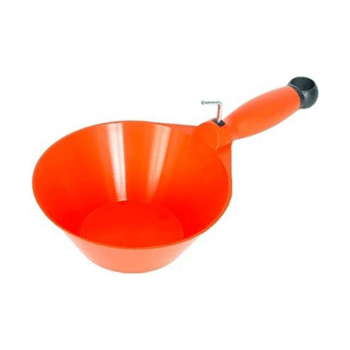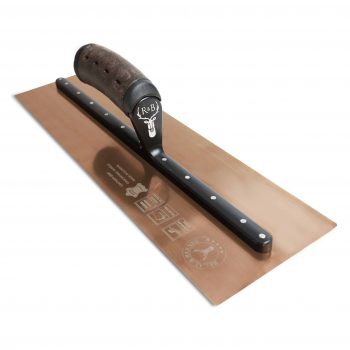Spray Rendering or Hand Application – What’s Better?
When it comes to applying render on a building’s exterior, two main methods come to mind: spray rendering and hand application. Both techniques have advantages and challenges, making choosing between them a critical decision for both contractors and homeowners.
What is rendering?
Rendering is a construction technique used to apply a smooth or textured protective layer of plaster to the exterior or interior walls of a building. This layer, commonly made from a mixture of cement, sand, lime, and water, serves multiple purposes. It enhances the building’s aesthetic appeal by providing a uniform or decorative finish, which can be painted or left as is, depending on the desired look. Rendering can also be adapted to include different colours or textures by adjusting the mix or application technique.
Beyond aesthetics, rendering is crucial in protecting a building’s structural integrity. It acts as a barrier against external elements like rain, snow, and changes in temperature, which can cause damage over time. Sealing the exterior and rendering help prevent water ingress, reducing the risk of dampness and structural decay. This is particularly important in climates that experience severe weather conditions.
Moreover, rendering can significantly improve a building’s thermal performance. The layer added to the walls helps to insulate the building, keeping it warmer in the winter and cooler in the summer. This can reduce energy costs, as less heating or cooling is required to maintain a comfortable indoor environment.
The rendering process involves preparing the wall surface, mixing the render materials to the correct consistency, and then applying the mixture either manually with tools like trowels and hawks or mechanically using spray machines. The choice between manual or mechanical application depends on the project’s scale and the required finish. The drying time for render can vary, but it typically needs to set and harden over several days, during which it must be protected from extreme weather conditions to ensure a smooth, durable finish.
Spray rendering
Spray rendering is a modern method of applying render that uses mechanical equipment to streamline the process, making it faster and often more cost-effective for large-scale projects. This technique involves using a spray machine that pumps the render mix through a hose to a spray gun, which is then applied to the wall in an even layer. Crucially, spray machines can also handle basecoat so that the retrofitting process can be accelerated. This approach is particularly favoured in commercial and new-build residential projects due to its efficiency and ability to cover vast areas swiftly.
Process
The process starts with preparing the render mixture, which typically consists of components like cement, lime, sand, and water, although proprietary mixes are also common. This mixture is then fed into the spray machine and kept under constant pressure. The machine delivers the render through a hose to a handheld spray gun, evenly distributing the render across the wall’s surface. The spray nozzle atomises the render, which ensures even distribution across the surface. The operator will work in small circles to aid the even distribution of the render.
Operators can control the thickness of the layer and the area covered by adjusting the machine settings and the technique used during application. Uniform coverage is one of the standout advantages of spray rendering, as it minimises human error and ensures a consistent finish across large surfaces.
Advantages
- Efficiency: Spray rendering significantly speeds up the application process, allowing for quick coverage of large areas, which can greatly reduce the time required to complete a project.
- Labour reduction: Using a machine to apply the render reduces the physical demand on workers, and fewer labourers are needed to cover the same area compared to hand application. This can lead to wage savings and potentially lower insurance costs due to the decreased risk of physical strain.
- Consistency: Spray rendering’s mechanical nature offers a consistent mix and application rate, reducing the likelihood of human error and ensuring uniform quality across the entire project.
- Versatility: Modern spray rendering machines can apply different types of render, including those with special additives or properties, such as increased elasticity or thermal insulation. They can also handle different textures, which can be adjusted according to project requirements.
Disadvantages
- Initial investment: The cost of acquiring high-quality spray rendering equipment can be considerable. Additionally, the maintenance of the machines adds to the overhead, making it less economical for small projects.
- Training and skill: Operating spray rendering equipment effectively requires specific skills and training. The operators need to know the machine settings and techniques to achieve the desired finish, which can involve additional training costs.
-
Euromair DropPro 8P – Thin Coat Render Spray Machine Kit
From £5,040.00 Incl. VATFrom £4,200.00 Excl. VAT
Traditional hand application
Hand application of render is the traditional method that involves manually applying a plaster-like mixture to walls using tools such as trowels, hawks, and floats. This technique has been used for centuries and remains popular for its precision and adaptability, especially suitable for smaller projects.
Process
The process of traditional hand application will remain similar, irrespective of what type of render you choose. Some renders will require a different tool for finishing; for example, a monocouche render is cratched back with a monocouche scraper. However, the application process is similar. Silicone renders arrive ready to use; therefore, the bucket must be mixed gently with a paddle mixer to distribute the aggregate evenly. Once complete, you can use a scoop to add some render on a hawk. A hawk is essentially a large flat plate with a handle that helps you hold a small amount of render as you work. It can also catch the render that falls off as you apply it with a trowel. Once the render is applied, it must be rubbed with a plastic float to distribute the aggregate more evenly.
Different types of render may require a secondary layer. For example, lime render often requires a first coat before a finishing coat. This adds to the time aspect of traditional hand application. Hand application also requires you to maintain a wet edge on the render; a wet edge ensures that the resultant finish has no trowel marks.
Advantages
- Precision and control: Hand application allows for meticulous control over the application, making it ideal for achieving specific finishes or working with intricate architectural features. Artisans can adjust the thickness and texture as they go, tailoring the application to the unique contours and details of the building.
- Flexibility in material mix: This method allows for on-site adjustments to the mix, accommodating different finishes and materials without needing specialised equipment. It’s particularly useful when dealing with traditional or heritage buildings that require specific materials to maintain their character.
- Lower start-up costs: Hand application does not require expensive machinery, making it accessible for smaller contractors or those undertaking DIY projects. The tools needed are relatively inexpensive and easy to obtain.
-
Regal & Barnes – Render Float (Trade Edition) – 3mm (280mm x 130mm)
£9.82 Incl. VAT£8.18 Excl. VAT -
PVC Plastering Scoop – 165mm
From £8.02 Incl. VATFrom £6.68 Excl. VAT -
Regal & Barnes – Hardened Stainless Steel Trowel (Specialist Edition) – 457mm
£49.30 Incl. VAT£41.08 Excl. VAT
Disadvantages
- Labour-intensive: The method is physically demanding and requires a significant amount of manual labour, which can lead to higher long-term costs in terms of wages and potential health-related issues for workers.
- Time-consuming: Hand applying render is much slower than spray techniques, particularly on large surfaces. This can extend project timelines and may not be feasible for tight schedules.
- Skill dependent: The quality of the finish heavily relies on the skill and experience of the tradesperson. Inconsistent skill levels can lead to uneven finishes, requiring additional time and resources to correct.
What’s the verdict – spray rendering or hand application?
Ultimately, this decision is down to you. Due to the lower costs, smaller projects, companies, and DIYers will likely stick to hand applications. You can attend the EWI Pro Training Academy and learn the necessary skills to apply the render manually. However, larger companies working on commercial projects will reap the benefits of investing in spray machines and spray rendering expertise. The time and wastage saved will pay off the initial investment in a shorter time.
Facebook
Twitter
LinkedIn
Your cart
Trade Account Login

We use cookies on our website to give you the most relevant experience by remembering your preferences and repeat visits. By clicking “Accept All”, you consent to the use of ALL the cookies. However, you may visit "Cookie Settings" to provide personalised consent.
Manage consent
Privacy Overview
This website uses cookies to improve your experience while you navigate through the website. Out of these, the cookies that are categorized as necessary are stored on your browser as they are essential for the working of basic functionalities of the website. We also use third-party cookies that help us analyze and understand how you use this website. These cookies will be stored in your browser only with your consent. You also have the option to opt-out of these cookies. But opting out of some of these cookies may affect your browsing experience.
Necessary cookies are absolutely essential for the website to function properly. These cookies ensure basic functionalities and security features of the website, anonymously.
| Cookie | Duration | Description |
|---|---|---|
| __stripe_mid | 1 year | This cookie is set by Stripe payment gateway. This cookie is used to enable payment on the website without storing any patment information on a server. |
| __stripe_sid | 30 minutes | This cookie is set by Stripe payment gateway. This cookie is used to enable payment on the website without storing any patment information on a server. |
| _GRECAPTCHA | 5 months 27 days | This cookie is set by the Google recaptcha service to identify bots to protect the website against malicious spam attacks. |
| apbct_cookies_test | session | CleanTalk sets this cookie to prevent spam on comments and forms and act as a complete anti-spam solution and firewall for the site. |
| apbct_page_hits | session | CleanTalk sets this cookie to prevent spam on comments and forms and act as a complete anti-spam solution and firewall for the site. |
| apbct_prev_referer | session | Functional cookie placed by CleanTalk Spam Protect to store referring IDs and prevent unauthorized spam from being sent from the website. |
| apbct_site_landing_ts | session | CleanTalk sets this cookie to prevent spam on comments and forms and act as a complete anti-spam solution and firewall for the site. |
| apbct_site_referer | 3 days | This cookie is placed by CleanTalk Spam Protect to prevent spam and to store the referrer page address which led the user to the website. |
| apbct_timestamp | session | CleanTalk sets this cookie to prevent spam on comments and forms and act as a complete anti-spam solution and firewall for the site. |
| apbct_urls | 3 days | This cookie is placed by CleanTalk Spam Protect to prevent spam and to store the addresses (urls) visited on the website. |
| AWSALBCORS | 7 days | This cookie is managed by Amazon Web Services and is used for load balancing. |
| cookielawinfo-checkbox-advertisement | 1 year | Set by the GDPR Cookie Consent plugin, this cookie is used to record the user consent for the cookies in the "Advertisement" category . |
| cookielawinfo-checkbox-analytics | 11 months | This cookie is set by GDPR Cookie Consent plugin. The cookie is used to store the user consent for the cookies in the category "Analytics". |
| cookielawinfo-checkbox-functional | 11 months | The cookie is set by GDPR cookie consent to record the user consent for the cookies in the category "Functional". |
| cookielawinfo-checkbox-necessary | 11 months | This cookie is set by GDPR Cookie Consent plugin. The cookies is used to store the user consent for the cookies in the category "Necessary". |
| cookielawinfo-checkbox-others | 11 months | This cookie is set by GDPR Cookie Consent plugin. The cookie is used to store the user consent for the cookies in the category "Other. |
| cookielawinfo-checkbox-performance | 11 months | This cookie is set by GDPR Cookie Consent plugin. The cookie is used to store the user consent for the cookies in the category "Performance". |
| ct_checkjs | session | CleanTalk–Used to prevent spam on our comments and forms and acts as a complete anti-spam solution and firewall for this site. |
| ct_fkp_timestamp | session | CleanTalk sets this cookie to prevent spam on the site's comments/forms, and to act as a complete anti-spam solution and firewall for the site. |
| ct_pointer_data | session | CleanTalk sets this cookie to prevent spam on the site's comments/forms, and to act as a complete anti-spam solution and firewall for the site. |
| ct_ps_timestamp | session | CleanTalk sets this cookie to prevent spam on the site's comments/forms, and to act as a complete anti-spam solution and firewall for the site. |
| ct_sfw_pass_key | 1 month | CleanTalk sets this cookie to prevent spam on comments and forms and act as a complete anti-spam solution and firewall for the site. |
| ct_timezone | session | CleanTalk–Used to prevent spam on our comments and forms and acts as a complete anti-spam solution and firewall for this site. |
| elementor | never | This cookie is used by the website's WordPress theme. It allows the website owner to implement or change the website's content in real-time. |
| viewed_cookie_policy | 11 months | The cookie is set by the GDPR Cookie Consent plugin and is used to store whether or not user has consented to the use of cookies. It does not store any personal data. |
Functional cookies help to perform certain functionalities like sharing the content of the website on social media platforms, collect feedbacks, and other third-party features.
| Cookie | Duration | Description |
|---|---|---|
| __zlcmid | 1 year | This cookie is used by Zendesk live chat and is used to store the live chat ID. |
| bcookie | 2 years | LinkedIn sets this cookie from LinkedIn share buttons and ad tags to recognize browser ID. |
| bscookie | 2 years | LinkedIn sets this cookie to store performed actions on the website. |
| lang | session | LinkedIn sets this cookie to remember a user's language setting. |
| lidc | 1 day | LinkedIn sets the lidc cookie to facilitate data center selection. |
| UserMatchHistory | 1 month | LinkedIn sets this cookie for LinkedIn Ads ID syncing. |
Performance cookies are used to understand and analyze the key performance indexes of the website which helps in delivering a better user experience for the visitors.
| Cookie | Duration | Description |
|---|---|---|
| __utma | 2 years | This cookie is set by Google Analytics and is used to distinguish users and sessions. The cookie is created when the JavaScript library executes and there are no existing __utma cookies. The cookie is updated every time data is sent to Google Analytics. |
| __utmb | 30 minutes | Google Analytics sets this cookie, to determine new sessions/visits. __utmb cookie is created when the JavaScript library executes and there are no existing __utma cookies. It is updated every time data is sent to Google Analytics. |
| __utmc | session | The cookie is set by Google Analytics and is deleted when the user closes the browser. It is used to enable interoperability with urchin.js, which is an older version of Google Analytics and is used in conjunction with the __utmb cookie to determine new sessions/visits. |
| __utmt | 10 minutes | Google Analytics sets this cookie to inhibit request rate. |
| __utmv | 2 years | The __utmv cookie is set on the user's device, to enable Google Analytics to classify the visitor. |
| __utmz | 6 months | Google Analytics sets this cookie to store the traffic source or campaign by which the visitor reached the site. |
| sib_cuid | 6 months | Purechat uses this cookie to send data to purechat.com, to connect visitors to the reservation team and track visitors to stay on portal. |
| SRM_B | 1 year 24 days | Used by Microsoft Advertising as a unique ID for visitors. |
Analytical cookies are used to understand how visitors interact with the website. These cookies help provide information on metrics the number of visitors, bounce rate, traffic source, etc.
| Cookie | Duration | Description |
|---|---|---|
| _ga | 2 years | The _ga cookie, installed by Google Analytics, calculates visitor, session and campaign data and also keeps track of site usage for the site's analytics report. The cookie stores information anonymously and assigns a randomly generated number to recognize unique visitors. |
| _gat_gtag_UA_61069204_2 | 1 minute | Set by Google to distinguish users. |
| _gat_UA-61069204-2 | 1 minute | A variation of the _gat cookie set by Google Analytics and Google Tag Manager to allow website owners to track visitor behaviour and measure site performance. The pattern element in the name contains the unique identity number of the account or website it relates to. |
| _gcl_au | 3 months | Provided by Google Tag Manager to experiment advertisement efficiency of websites using their services. |
| _gid | 1 day | Installed by Google Analytics, _gid cookie stores information on how visitors use a website, while also creating an analytics report of the website's performance. Some of the data that are collected include the number of visitors, their source, and the pages they visit anonymously. |
| _uetsid | 1 day | This cookies are used to collect analytical information about how visitors use the website. This information is used to compile report and improve site. |
| CONSENT | 2 years | YouTube sets this cookie via embedded youtube-videos and registers anonymous statistical data. |
Advertisement cookies are used to provide visitors with relevant ads and marketing campaigns. These cookies track visitors across websites and collect information to provide customized ads.
| Cookie | Duration | Description |
|---|---|---|
| _fbp | 3 months | This cookie is set by Facebook to display advertisements when either on Facebook or on a digital platform powered by Facebook advertising, after visiting the website. |
| ANONCHK | 10 minutes | The ANONCHK cookie, set by Bing, is used to store a user's session ID and also verify the clicks from ads on the Bing search engine. The cookie helps in reporting and personalization as well. |
| fr | 3 months | Facebook sets this cookie to show relevant advertisements to users by tracking user behaviour across the web, on sites that have Facebook pixel or Facebook social plugin. |
| MUID | 1 year 24 days | Bing sets this cookie to recognize unique web browsers visiting Microsoft sites. This cookie is used for advertising, site analytics, and other operations. |
| NID | 6 months | NID cookie, set by Google, is used for advertising purposes; to limit the number of times the user sees an ad, to mute unwanted ads, and to measure the effectiveness of ads. |
| test_cookie | 15 minutes | The test_cookie is set by doubleclick.net and is used to determine if the user's browser supports cookies. |
| uuid | 6 months | MediaMath sets this cookie to avoid the same ads from being shown repeatedly and for relevant advertising. |
| VISITOR_INFO1_LIVE | 5 months 27 days | A cookie set by YouTube to measure bandwidth that determines whether the user gets the new or old player interface. |
| YSC | session | YSC cookie is set by Youtube and is used to track the views of embedded videos on Youtube pages. |
| yt-remote-connected-devices | never | YouTube sets this cookie to store the video preferences of the user using embedded YouTube video. |
| yt-remote-device-id | never | YouTube sets this cookie to store the video preferences of the user using embedded YouTube video. |
| yt.innertube::nextId | never | This cookie, set by YouTube, registers a unique ID to store data on what videos from YouTube the user has seen. |
| yt.innertube::requests | never | This cookie, set by YouTube, registers a unique ID to store data on what videos from YouTube the user has seen. |
Other uncategorized cookies are those that are being analyzed and have not been classified into a category as yet.
| Cookie | Duration | Description |
|---|---|---|
| _clck | 1 year | No description |
| _clsk | 1 day | No description |
| _uetvid | 1 year 24 days | No description available. |
| AnalyticsSyncHistory | 1 month | No description |
| apbct_pixel_url | session | No description |
| apbct_visible_fields_0 | session | No description |
| apbct_visible_fields_1 | session | No description |
| apbct_visible_fields_10 | session | No description |
| apbct_visible_fields_2 | session | No description |
| apbct_visible_fields_3 | session | No description |
| apbct_visible_fields_4 | session | No description |
| apbct_visible_fields_5 | session | No description |
| apbct_visible_fields_6 | session | No description |
| apbct_visible_fields_7 | session | No description |
| apbct_visible_fields_8 | session | No description |
| apbct_visible_fields_9 | session | No description |
| ct_checked_emails | session | No description |
| ct_has_scrolled | session | No description |
| ct_mouse_moved | session | No description |
| ct_screen_info | session | No description |
| ictf_master | never | No description available. |
| li_gc | 2 years | No description |
| m | 2 years | No description available. |
| SM | session | No description available. |
| testinfinitycookie | session | No description |
| woocommerce_show_tax | 7 days | No description available. |
| wp_woocommerce_session_c5ac76b408021294cb56bcc27eddf8a1 | 2 days | No description |








